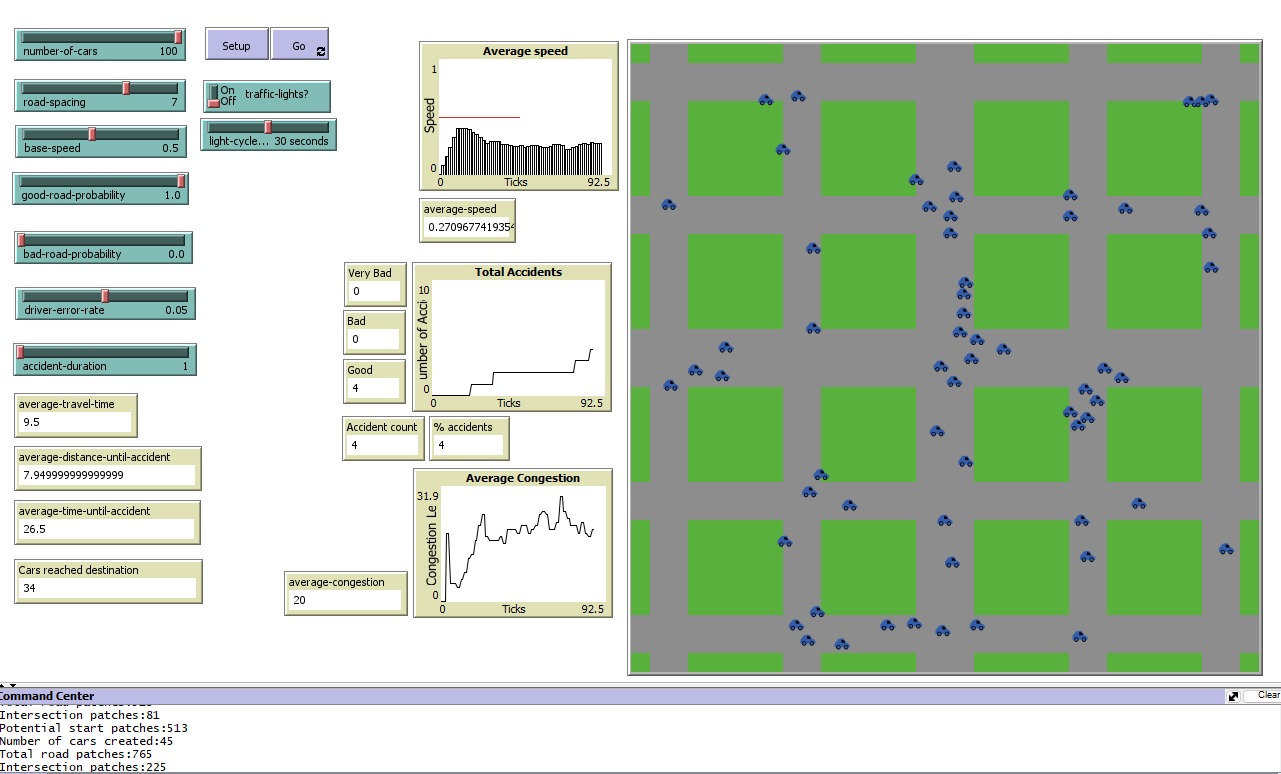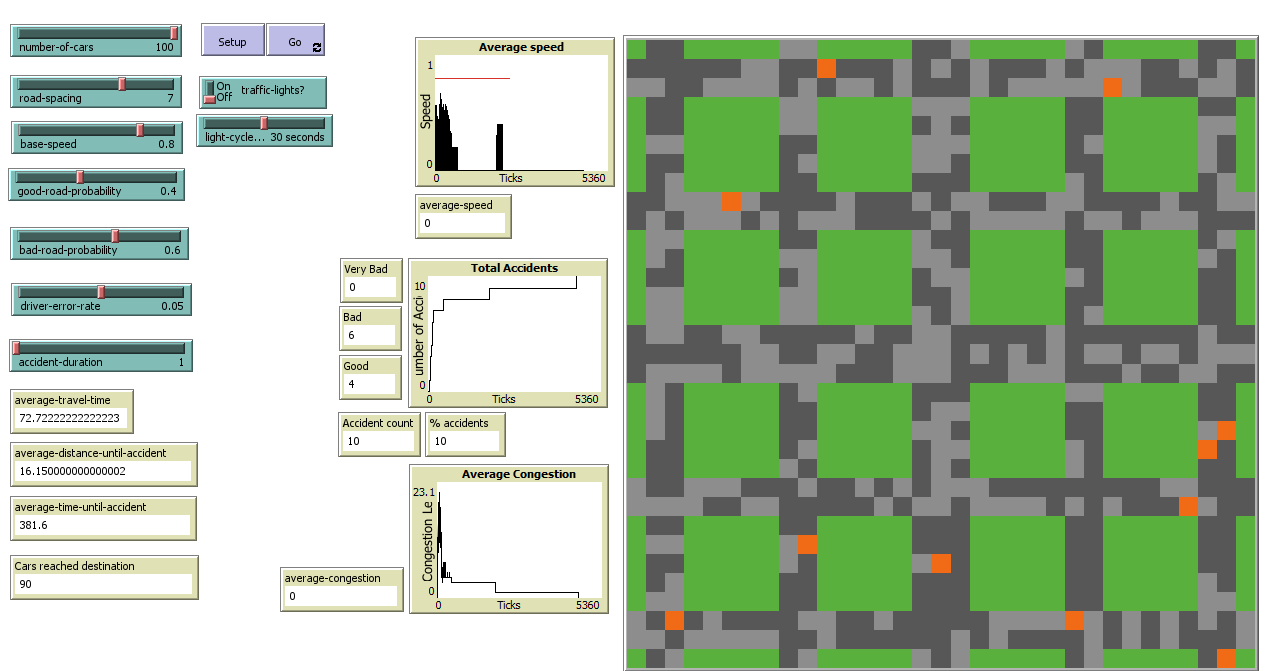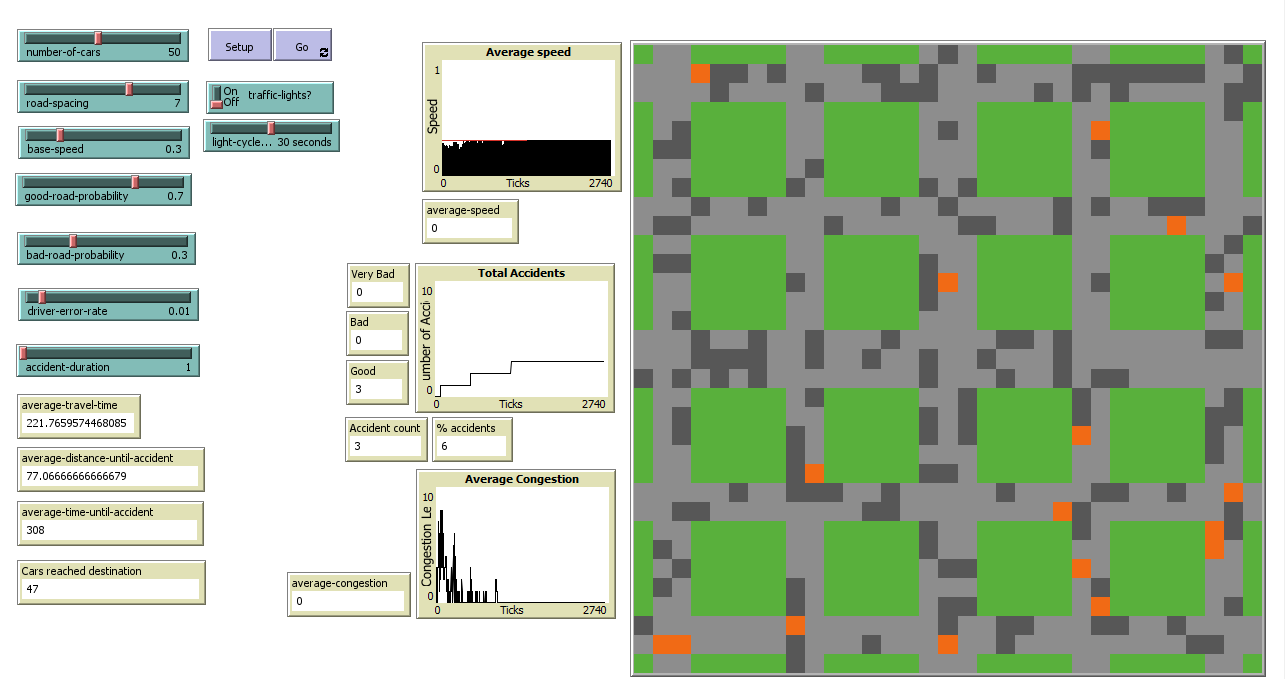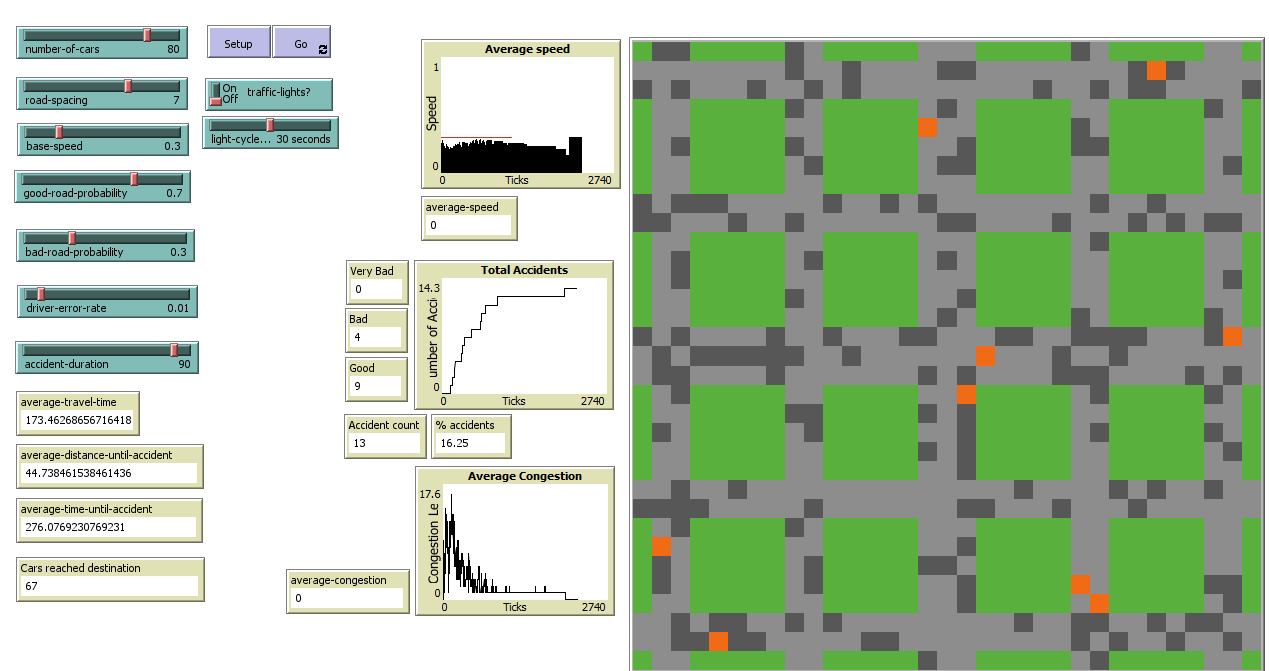Traffic Accident Risk Analysis
Contents
Introduction
This page introduces a NetLogo-based simulation that models traffic accident risk. The goal is to understand how road conditions, traffic density, and driver behavior intertwine to create or mitigate accidents. Various research sources underscore the need for a systematic approach to traffic safety, illustrating how driver reliability, infrastructure, and cultural factors shape accident outcomes (Sadauskas, 2011; Gstalter & Fastenmeier, 2010; TSK Praha, 2020; Nordfjærn et al., 2011).
Definition of the Problem
Road traffic accidents remain a pressing public health challenge, especially with the steady growth in vehicle numbers worldwide (Sadauskas, 2011). This proliferation escalates the likelihood of collisions, injuries, and fatalities. A robust traffic safety strategy thus necessitates examining:
Road conditions (from good to very bad).
Driver behavior and risk homeostasis (adjusting behavior based on perceived safety).
Environmental and societal factors that influence compliance with safety rules (Nordfjærn et al., 2011).
Moreover, the complexity of urban intersections can amplify error rates, as drivers face higher cognitive loads and multiple conflict points (Gstalter & Fastenmeier, 2010). In city contexts, baseline accident rates still vary considerably depending on infrastructure, as seen in real-world data (TSK Praha, 2020).
Method
A systematic approach to traffic safety integrates engineering, enforcement, and education — often referred to as the “Triple E” (Sadauskas, 2011):
Engineering: Vehicle and road design improvements (e.g., signage, intersections, lighting).
Education: Public awareness, driver training programs targeting risk perception and behavior.
Enforcement: Legal measures (speed limits, penalties) ensuring compliance with traffic rules.
Human Reliability Analysis (HRA) has also been adapted to driving tasks to quantify driver error probabilities at intersections (Gstalter & Fastenmeier, 2010). By defining “correct” driver actions and measuring deviations, one can estimate how road geometry, age, and psycho-social factors alter driver reliability.
Model
This simulation uses NetLogo to create a grid of patches representing:
Road segments: Assigned good, bad, or very bad condition.
Intersections: Potentially with traffic lights.
Cars (turtles): Move according to lane rules and can trigger accidents based on speed, congestion, and driver-error-rate.
Key points:
Accident Probability: Derived from a base driver-error-rate, amplified by intersection complexity, road condition, and local traffic density (Gstalter & Fastenmeier, 2010; Nordfjærn et al., 2011).
Baseline Rates: Inspired by real accident data (e.g., TSK Praha’s ročenka dopravy or Accident risks of different weather conditions) (TSK Praha, 2020) (Malin 2017).
Systematic Approach: Reflects suggestions for engineering (road condition logic), education (driver-error slider), and enforcement (speed constraints) in modeling different scenarios (Sadauskas, 2011).
Interface
High Density, Poor Roads
Because there are 100 cars with a fairly high driver-error-rate (0.05), multiple accidents occurred (10 total). However, they tended to happen later in the simulation (average time until accident over 300 ticks). Most cars (90 out of 100) still reached their destination—likely because accident-duration is very short (1 tick), so blocked patches quickly returned to normal. The relatively high base speed (0.8) also increased mobility, helping more cars finish faster, but also contributed to a moderate accident rate.
Low Density, Strict Limits
Fewer cars (50), but also a much lower base speed (0.3), so cars move more slowly—leading to a higher average travel time (over 200 ticks). Because driver-error-rate is only 0.01 (lower chance of human error) and 70% roads are good, only 3 accidents occurred. Even with slow speed, many cars still took a long time to finish, as shown by the high travel time. Almost all cars managed to complete or crash within the time frame, with 47 successful arrivals.
Moderate Density, Extended Accident Duration
Compared to the second screenshot, the big difference is accident-duration = 90 (very long). Even though speed is still 0.3 and the road condition/distribution is the same, the accident count has climbed to 13, and 16% of the cars ended up in accidents. Because accidents last 90 ticks on a patch, any collision severely disrupts traffic, likely forcing more cars to queue or collide. Despite that, 67 cars did manage to exit, though the blocked patches would have contributed to higher accident numbers and more emergent congestion.
Conclusion
NetLogo model offers a flexible testbed for exploring how each factor contributes to — or mitigates — traffic accidents. Real-world calibration data (e.g., from TSK Praha) can refine the baseline accident probabilities, enabling more realistic scenario testing.
Code
Below is the NetLogo code implementing the simulation structure (patch definitions, accident logic, congestion metrics, etc.). Users can copy and paste it into a NetLogo environment to run their own experiments. For a complete listing, see the setup, go, and supporting procedures:
References
Sadauskas, V. (2011). Traffic safety strategies, Transport, 18(2), 79–83. DOI: 10.1080/16483840.2003.10414070
Gstalter, H., & Fastenmeier, W. (2010). Reliability of drivers in urban intersections. Accident Analysis & Prevention, 42(1), 225–234. Link
TSK Praha (2020). Ročenka dopravy – 2020. Link
Nordfjærn, T., Jørgensen, S., & Rundmo, T. (2011). A cross-cultural comparison of road traffic risk perceptions, attitudes towards traffic safety, and driver behaviour. Journal of Risk Research, 14(6), 657–684. Link
Fanny Malin (2017). Accident risks in different weather conditions. Link



